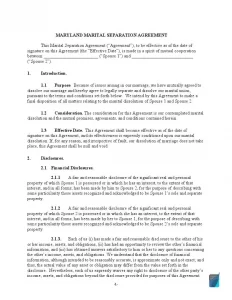Maryland Marital Settlement (Divorce) Agreement and Legal Separation
People do get married all the time, but they sometimes decide their marriage is no longer worthwhile. In these situations, if they reside in the Maryland state, they need to fill the Maryland Marital Settlement Agreement Form.
One should note that without this agreement, the partners cannot formalize and finalize the divorce procedure. The settlement covenant is a legitimate document containing information about the separation proceedings. The partners can prescribe all relevant conditions on property division, a minor’s support, future residence, shared guardianship, and other additional separation-related matters in the free marital settlement agreement template. Bear in mind that this would be a founding document for your future relations with the former spouse. Ensure you settle all doubtful or disputable matters peacefully.
We would advise spouses to have legal counsel’s assistance to file the Maryland Marital Settlement Agreement to ensure that the judge will examine their interests equally.

Build Your Document
Answer a few simple questions to make your document in minutes
Save and Print
Save progress and finish on any device, download and print anytime
Sign and Use
Your valid, lawyer-approved document is ready
The Maryland Marital Settlement Agreement must include the following items:
- Personal data of both partners, including their names, telephones, addresses, and emails
- The separation date
- The amount of alimony in American dollars
- Data on health insurance
- Description of spouses’ belongings
- Description of partners’ liabilities
- Information regarding change of names
- Signatures of the divorcing partners
- Various attachments covering a minor’s assistance, spousal assistance, belongings, and obligations.
Maryland Divorce and Separation Laws
Maryland Code and Court Rules include laws covering the separation and divorce procedure. The essential sections concerning separation in the state are:
- Title 7 of the Family law section (Divorce)
- Title 11 of the Family law section (Alimony)
- Title 12 of the Family law section (Child Support).
Please get acquainted with these topics below.
Grounds for Separation
Sections 7-102 and 103 of the State Code provide important and lawful reasons for getting a divorce. Couples can split in two ways in Maryland—they can either get a limited divorce (separation) or absolute divorce.
A divorcing procedure implies that the partners’ joint estate acquired during their marriage would be split lawfully between them. Besides, the judge would have to decide who keeps and looks out for the shared minors after the proceedings. If neither side has claims towards the other, the divorce is identified as “No-Fault.” As it appears from its name, such a procedure would be the smoothest option possible.
Some less pleasant and simple divorce procedures are also possible, and they are fault-based. This technically means that one of the partners has broken their mutual obligation somehow and that unlawful action has caused divorce initiation. Such kind of separation is not mutually intended and implies the following reasons:
- Severe violation with a sentence of at least three years
- Abandonment (usually, without reason)
- Brutality towards minor kids or either spouse
- Infidelity (alleged or proven)
- Madness (if a partner spends a minimum of three years in a mental hospital)
Limited divorce effectively means that the partners do not dwell together anymore, but they remain married by law. The reasoning behind opting for this type of divorce is most commonly abandonment, brutality towards minor kids, and allocation.
Property Division
To begin with, Maryland recognizes equitable distribution of valuable belongings and joint property. If a couple is trying to get a divorce, the state court will try to split the jointly acquired belongings between partners fair and square. The judge will mainly focus on the following aspects while making a decision:
- Marriage duration
- Partners’ economic situation
- Partners’ ages
- Contributions of every partner to the family’s welfare
- How partners purchased their belongings
- The reasoning for the spouses’ breakup
You can look into Section 8-205 of the Maryland Code for more information on this matter.
Child Support and Visitation
You can read about respective norms and regulations in Section 12-204 of the Maryland Code. Below, we have outlined essential information regarding this particular issue.
The minor can only stay with one of the parents, and that is a rule. However, that does not mean that the other parent has to stay out of the kid’s life (or children’s lives if there are more than one offspring). Usually, the law obliges the other parent to make monthly support payments, which is a minimum requirement for the minor’s support. The payment amount depends on many factors, including the number of kids, the spouses’ earnings, required medical costs, and the time kids spent with the parent.
Popular Local Marital Settlement Agreement Forms
While it’s not required to write a marital settlement agreement, doing this can give you a couple of benefits: extra confidence in your post-marital life and significantly less pain in court. Here’s a list of this sort of local agreements searched the most by our site visitors.
Residency Matters
The state offers specific requirements of residence to perform a divorce procedure. The state authorities demand that one of the spouses be a Maryland citizen for a minimum of six months. Otherwise, the couple will not be eligible to file for a divorce.
Child Support and Alimony
Information on this is in §11-106 of the Maryland Code.
Occasionally, the courts legally force one of the parents to pay alimony to another parent dwelling with kids. The judge’s judgment on this depends on the following:
- Partners’ age
- Marriage duration
- Couple’s financial commitments
- Partners’ mental and physical state
- The partners’ capability to be independent
- The partners’ capacity to provide education
- Partners’ funding requirements
Partners can get interim support while the court is considering their application. For that, they need to request financial assistance per Section 11-106 of the State Code.

Filing for Divorce in Maryland
To complete the separation process easily, use our form-building software. It will save your time (and nerves), so you can spend it on more exciting activities.
Note that you have to pay a filing fee for your marital settlement agreement to be accepted. If you’re self-represented, you will pay $165 and $185 if you have an attorney to represent your interests.
1. Select the Necessary Form
This legal process implies a lot of paperwork due to its social and economic significance. We encourage you to utilize our software to build any required legal form and fill it online. Choose the form that suits your needs and demands in the best possible way.
Pay attention to the list of documents you have to provide along with your divorce application. The list differs depending on whether there are minors involved in the procedure. Usually, you have to file an affidavit, report on your domestic civil case, and reply to the petition (or the petition itself). If you have kids involved, you need to add a payment waiver, request a trial, a parenting plan, and other forms explicitly applied in Maryland.
No matter what form you’re choosing, the manner of registering it is almost the same.
2. Complete the Divorce Form at the Circuit Court
One of the partners (the complainant) has to fill the Financial Statement, the Civil Domestic Case Information Report, and the Complaint about Absolute Divorce. By doing this, the plaintiff is filing for “absolute divorce.”
The complainant then takes these papers to the circuit court of that country or city where the two spouses reside. This is when the complainant pays the filing fee of $165 at the minimum. However, if they submit a Waiver of Prepayment of Prepaid Costs, they can skip paying the fees.
3. Transfer Documents to the Defendant
The complainant has to file a Writ of Summons (WOS) after filling the legal papers from the previous paragraph. The circuit court will provide the complainant with this document. After completing one, they should send it and duplicate separation papers to the defendant using the assistance of a third party 60 days after the summon date.
Three examples of third parties that could transfer divorce documents are:
- A person aged at least 18 years and not part of the separation process can transfer documents personally or by confirmed mail.
- A private process server can also be an option.
- The sheriff’s office in the country where the defendant resides is another option.
4. Provide the Defendant’s Response
The defendant can express their position towards their marital partner’s appeal. They have 30 days to wait or file a counter-complaint in response. Please note that completion of the document is necessary when the defendant has different reasons for separation. Also, note that they do not need to mention these grounds in the previous appeal.
5. Complete Additional Legal Papers
The complainant and defendant need to fill in additional forms before the trial. Amongst these papers, they need the following:
- Parental Plan. A document describing in detail how you are going to care for mutual minors.
- Joint Statement. This legal form contains all the necessary details about marital and non-marital private belongings of the spouses (please only indicate assets acquired during the marriage).
- Former Name Restoration. If you decide not to keep your married name after divorce, you can easily change it to the way it was before marriage.
- Marital Settlement Covenant. This form will help you formalize the separation procedure. We strongly advise you to read the related articles on our website for more data. You can also utilize our form-building software to get the necessary legal form.
6. Ask for a Proceeding
To request a proceeding without delay, partners need to file all the legal separation papers. The complainant also needs to fill a Request for Hearing or Proceeding. If partners achieved consent, the complainant should choose the “uncontested hearing” option.
Afterward, a registrar chooses the hearing date and notifies the complainant. In their turn, the complainant notifies the defendant about the date and place of the hearing.
7. Receive the Final Decree After the Final Court
The presence of partners in the court is a must. Without that, the termination of the marriage is impossible.
If partners have consented to all matters described above, they can release an Absolute Divorce Decree. If there’re mutual claims between two parties, the judge examines them and then passes judgment. When the final determination is made, the separation proceedings are over.
Spouses can restore their pre-marriage names once the procedure is over. They just need to sign, date, and file the relevant petition form with the respective local authorities and proceed to the circuit court.
When the separation termination process is over, spouses can marry new partners (or each other again, which is also possible) anytime they like. If they want to apply for a marriage license, they have to wait for 48 hours—enough time to think if you’re making the right choice.

Listed here are some other Maryland templates completed by FormsPal visitors. Check out our step-by-step tool to customize any of these documents to your preferences.
Other Marital Settlement Agreement Forms by State